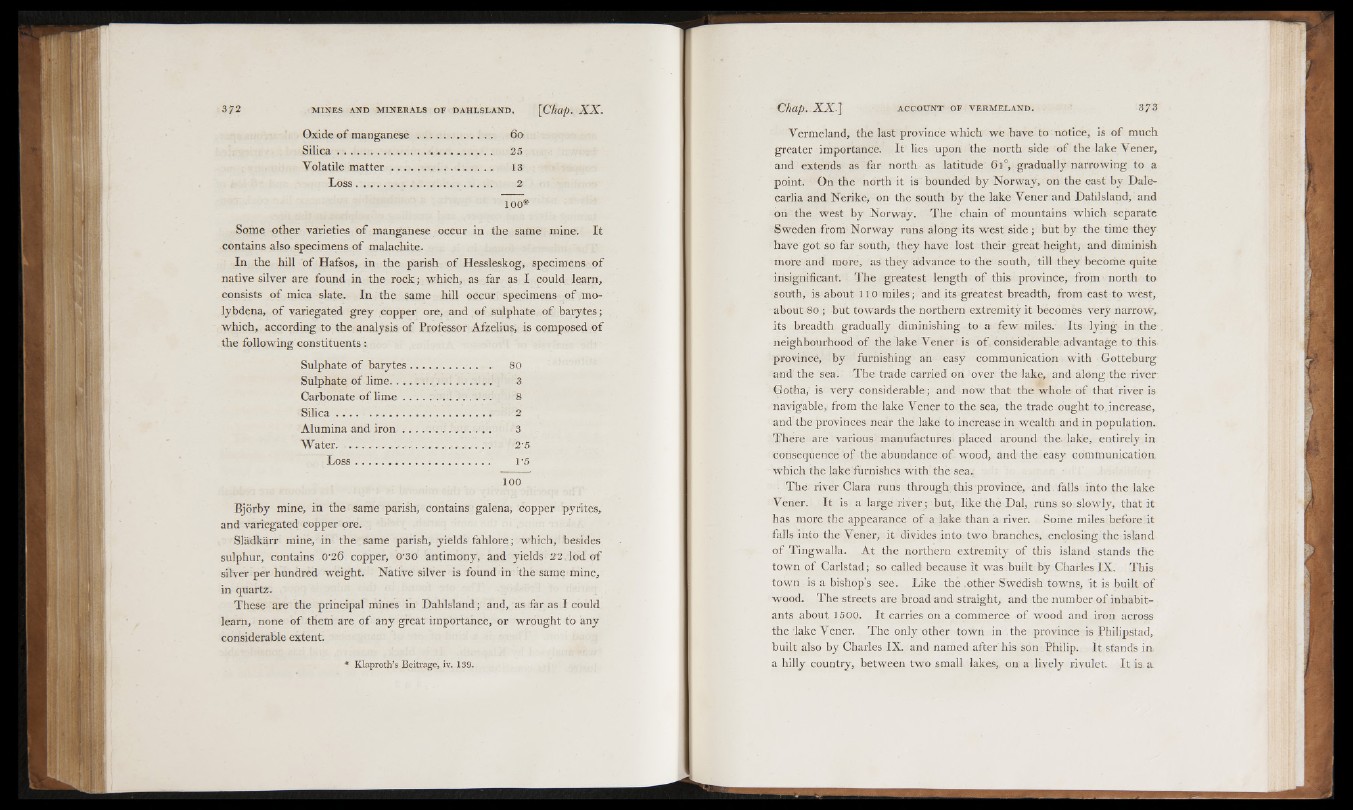
Oxide o f manganese......................... 60
S ilic a .............. v . .......... 25
Volatile matter ........................... 13
Loss.................... 2
loo*
Some other varieties o f manganese occur in the same mine. It
contains also specimens of malachite.
In the hill o f Hafsos, in the parish o f Hessleskog, specimens of
native silver are found in the rock; which, as far as I could learn,
consists o f mica slate. In the same hill occur specimens of mo-
lybdena, o f variegated grey copper ore, and of sulphate of barytes;
which, according to the analysis of Professor Afzelius, is composed o f
the following constituents:
Sulphate o f barytes...................... . 80
Sulphate of lime............................... .. 3
Carbonate o f lim e ............................. 8
S ilic a ................................................... 2
Alumina and ir o n 3
Water. .................. ........................... 2'5
L o s s .................. ....................... .. 1'5
100
Bjorby mine, in the same parish, contains galena, copper pyrites,
and variegated copper ore.
Sladkarr mine, in the same parish, yields fahlore; which, besides
sulphur, contains 0 '2 6 copper, 0'3o antimony, and yields 2 2 , lod of
silver per hundred weight. Native silver is found in the same mine,
in quartz.
These are the principal mines in Dablsland; and, as far as I could
learn, none of them are of any great importance, or wrought to any
considerable extent.
* Klaproth’s Beitrage, iv. 139.
Vermeland, the last province which we have to notice, is of much
greater importance. It lies upon the north side of the lake Vener,
and extends as far north as latitude 6l°, gradually narrowing to a
point. On the north it is bounded by Norway, on the east by Dale-
carlia and Nerike, on the south by the lake Vener and Dablsland, and
on the west by Norway. The chain o f mountains which separate
Sweden from Norway runs along its west side ; but by the time they
have got so far south, they have lost their great height, and diminish
more and more, as they advance to the south, till they become quite
insignificant. The greatest length o f this province, from north to
south, is about 110 miles; and its greatest breadth, from east to west,
about 80 ; but towards the northern extremity it becomes very narrow,
its breadth gradually diminishing to a few miles. Its lying in the
neighbourhood of the lake Veneri is of. considerable, advantage to this
province, by furnishing an easy communieation with Gotteburg
and the sea. The trade carried on over the lake, and along the river
Gotha, is very considerable; and now that the whole o f that river is
navigable, from the lake Vener to the sea, the trade ought to increase,
and the provinces near the lake to increase in wealth and in population.
There áre various manufactures, placed around the. lake, entirely in
consequence of the abundance o f wood, and the easy communication
which the lake furnishes with the sea.
The river Clara runs through this province, ánd . falls into the lake
Vener. It is a large river; but, like the Dal, runs so slowly, that it
has more the appearance o f a lake than á river. Some miles before it
falls into the Vener, it divides into two branches, enclosing the island
of Tingwalla. At the northern extremity of this island stands the
town of Carlstad; so called because it was built by Charles IX. This
town is a bishop’s see. Like the .other Swedish towns, it is built of
wood. The streets are broad and straight, and the number of inhabitants
about 1500. It carries on a commerce o f wood and iron across
the lake Vener. The only other town in the province is Philipstad,
built also by Charles IX. and named after his son Philip. It stands in
a hilly country, between two small lakes,, on a lively rivulet. It is a